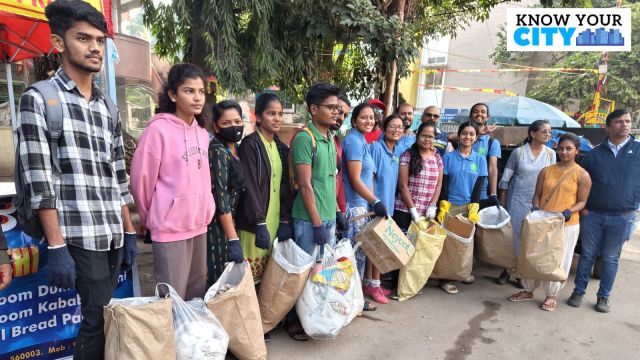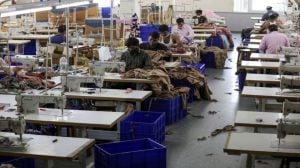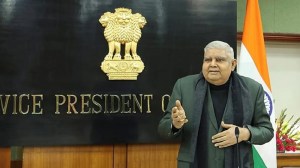Know Your City: Bengaluru’s tryst with humble groundnut at the Kadalekai Parishe
Kadalekai Parishe or groundnut festival begins at Kadu Malleshwara temple in Malleswaram (December 2 to 4), and will be subsequently held at the Dodda Basavanagudi or Bull temple from December 11 to 13.
 Volunteers with bags removing garbage is attributable to Raj of Indian Ploggers Army. (Express Photo)
Volunteers with bags removing garbage is attributable to Raj of Indian Ploggers Army. (Express Photo)
Across the streets of India, one of the most common sights is the groundnut seller and his cart, with roasted and boiled nuts served up in folded newspapers. Bengaluru, however, takes the love of this little nut to a different level.
For ages, the groundnut festival or Kadalekai Parishe has been a regular feature of the city as the Hindu month of Kartik comes to an end. The festival begins at the Kadu Malleshwara temple in Malleswaram, (December 2 to 4), and will be subsequently held at the Dodda Basavanagudi or Bull temple a week later (December 11 to 13). However, the historical association and oldest legends of the festival lie with the Bull Temple.
 For ages, the groundnut festival or Kadalekai Parishe has been a regular feature of the city as the Hindu month of Kartik comes to an end. (Express Photo by Jitendra M)
For ages, the groundnut festival or Kadalekai Parishe has been a regular feature of the city as the Hindu month of Kartik comes to an end. (Express Photo by Jitendra M)
According to city historian Arun Prasad, the early history of the festival and the associated temples can be traced back to the city’s founder, Kempe Gowda.
“The Bull Temple was built by Kempe Gowda I in the 16th century with imperial permission from the Vijayanagara emperor. He also expanded the Someshwara temple in Halasuru. The Bull Temple is also unique as it was built on a rocky hillock in the area. The idol of Nandi here is one of the largest monolithic bulls in a crouching position, apart from the one in Chamundi Hills in Mysore and Lepakshi in Andhra Pradesh,” Prasad says.
At the base of the bull, you can also find a Kannada inscription which describes the river Vrishabhavati originating here. This is also attested in colonial English scholar BL Rice’s Epigraphia Carnatica, where he notes that, “(The inscription)…. is probably of the Kempe Gauda period. It is inscribed at the base of the big bull in the Basavan-gudi or Bull temple, to the south of the Fort of Bangalore, which gives its name to the new extension of the City in that direction. The inscription states that the feet of the god there are the source of the Vrishabhavathi river, which runs to the west. It is an affluent area of the Arkavati, which it joins a few miles north of Kankanhalli.”
According to Prasad, the local legends which give rise to the Kadalekai Parishe go back to the village of Sunkenahalli which was earlier located here.
 This year, citizen’s groups are also making efforts to eliminate plastic bags from the festival entirely by partnering with the Bruhat Bengaluru Mahanagara Palike. (Express photo by Jithendra M)
This year, citizen’s groups are also making efforts to eliminate plastic bags from the festival entirely by partnering with the Bruhat Bengaluru Mahanagara Palike. (Express photo by Jithendra M)
One version of the legend has the local farmers building a temple to appease a bull which had destroyed their crops, while another version states that the bull itself turned to stone, with the temple being built around it. Subsequently, a tradition of offering groundnuts to the bull came about, which later on became the Kadalekai festival as it is known today.
Prasad notes that the festival might have originated at a further date than the construction of the temple, only after the Portuguese introduced the groundnut as a crop and went on to become popular in India.
This year, citizen’s groups are also making efforts to eliminate plastic bags from the festival entirely by partnering with the Bruhat Bengaluru Mahanagara Palike (BBMP) under the tagline ‘Parishege Banni, Cheela Tanni’ to encourage festival-goers to bring their own bags.
 According to city historian Arun Prasad, the early history of the festival and the associated temples can be traced back to the city’s founder, Kempe Gowda. (Express photo by Jithendra M)
According to city historian Arun Prasad, the early history of the festival and the associated temples can be traced back to the city’s founder, Kempe Gowda. (Express photo by Jithendra M)
The groups include the Indian Ploggers Army, Malleswaram Social, Beautiful Bharat etc. to name a few.
According to Raj, founder of the Ploggers Army, like-minded people are collaborating to ensure that the entire festival is plastic free. “We are providing alternatives like paper and cloth bags to vendors. There is a clear mandate from BBMP to only use plastic-free material,” he says.
Volunteers have already been busy clearing away waste around the festival area. A series of drop points is also available for people to donate cloth items such as old bedsheets and clothing which can be remade into cloth bags.
Meanwhile, for the Basavanagudi leg of the festival, the citizen’s group Heritage Beku is pushing for the BBMP to implement LED lighting to revive the historical tradition of lighting up the nearby Bugle Rock (ancient cavities can be seen in the rock at intervals, presumably cut out to place lamps inside.)












